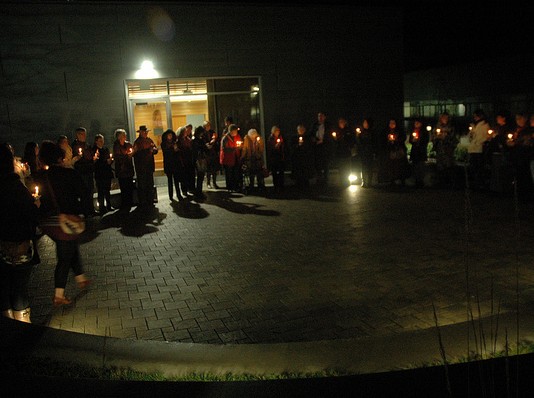Today is December 6, the 24th anniversary of the Montreal Massacre and the National Day of Remembrance and Action on Violence Against Women. Given that the massacre took place on a college campus, the day commemorating the murder of 14 women at Montreal’s École Polytechnique has particular significance for postsecondary institutions in Canada. Every year, December 6 is recognized at schools across the country and the murdered women remembered with candlelight vigils, film screenings and discussions.
December 6th was designated a national day of remembrance in 1991 with the explicit intention of drawing awareness to broader acts of violence against women in Canada. The ongoing need for this awareness is perhaps nowhere more apparent than at colleges and universities. The numbers are sordid and well-rehearsed: women ages 18-24 experience the highest rates of sexual violence in Canada (Statistics Canada), while four out of five female undergraduate students experience violence in a dating relationship. Sexual assaults markedly increase during the first few weeks of a new semester (Department of Justice, Factsheet on Dating Violence), and the majority of sexual assaults are never reported. This issue received national attention this fall when a string of night-time sexual assaults occurred at UBC, while rape and anti-Indigenous chants at UBC’s Sauder School of Business and Saint Mary’s University in Halifax signalled the ongoing perniciousness of rape culture on campuses across the country.
In recent years, events at universities have shifted in focus away from memorializing Marc Lépine’s victims and toward conversations about how to address sexual violence. The University of Victoria cancelled December 6 events two years ago after families requested that victims’ names not be repeated each year. The memorial has since been reinstated — an event was held on Wednesday of this week in the UVic Student Union Building that consisted of a collaborative essay, where participants were asked to share their thoughts on how they perceive resistance to violence. Alyson Kowalewsky, Outreach and Communications Coordinator for the Women’s Centre, says that event organizers “have been working hard to shift the focus from centering [on] the Ecole Polytechnique massacre to addressing violence that occurs to all women, particularly marginalized women.” Kowalewsky adds that there has been discussion within the Women’s Collective about how December 6 challenges violence against women how the National Day of Remembrance and Action fits into their mandate.
The annual event at the University of Windsor strikes a balance between remembering the victims of the massacre and promoting conversations about contemporary violence — this year, a candlelight vigil will be held at the University’s December 6 memorial, followed by a talk on masculinity and male performance. While talks in previous years have focused on acts against women, recent Windsor graduate Tracy Huynh thinks it is time to discuss the role played by cultural expectations of masculinity. “Males too are held against this script that really ties them down,” Huynh says, “just as much as women are held to a script to be submissive and docile.” Nevertheless, Huynh admits that attendance at the vigil each year varies; because December 6 coincides with finals at most schools, students are not often aware that the memorials are happening.
The designation of December 6 as a day of remembrance has also met with criticism about its potential to further marginalize groups of women who experience higher than average rates of violence. Kowalewsky writes:
The murders that took place at École Polythenique were tragic and unimaginable and we need to take the steps to ensure that such acts of misogyny never occur again. But the reality is that violence is occurring every day in different forms ranging from physical violence to racism and homophobia, to colonialism, and these acts of violence are not addressed by a commemoration of a specific massacre.
To that end, the UVSS Women’s Centre has begun focusing resources on actions that resist violence against LGBTQ women, women of colour, Indigenous women, women who engage in sex work, and disabled women. Catriona Gold, a Master’s student at UBC, echoes this sentiment, but also sees the Massacre as connected to “facets of a rape culture which extends beyond campus.” Gold, who spoke on a panel about campus rape at the Vancouver Rape Relief Shelter’s 2013 Montreal Massacre Memorial event, argues that the Polytechnique murders
are connected to all other violence against women, and especially the threats to women across university campuses. Lépine sought to cow feminists into submission; to silence the women’s movement; to scare all women away from our own places of work and study, back into the domestic sphere. The campus rapist and those who would exclude women from UBC’s campus after dark further the same end.
Ultimately, many agree that the only way to address sexual violence and rape culture on campus is through open dialogue with students. Lucia Lorenzi, a PhD candidate at UBC who blogged about the Sauder rape chants in September, thinks the events at UBC this year serve as reminders that “women are still constantly under siege in post-secondary settings.” Even if that violence takes a less extreme form than the murders of the massacre, Lorenzi thinks it is important to recognize that “women’s lives are still on the line,” as “incidents of harassment and violence can silence individuals in the classroom (or force them out of the classroom).” Gold argues that looking to university administrators to address rape culture isn’t an effective solution because these administrations are themselves “imbued with sexism” — and, as occurred with the Sauder rape chants, administrations often attempt to offload responsibility for misdeeds onto students. Ultimately, December 6 serves as a reminder, both of the Polytechnique Massacre and of ongoing, albeit sometimes less visible, forms of violence against women on postsecondary campuses. And while many feminists who work and study at universities agree that the memorial has its place in challenging violence and micro-aggressions, it is only part of an ongoing conversation.
Image: flickr/uvf



